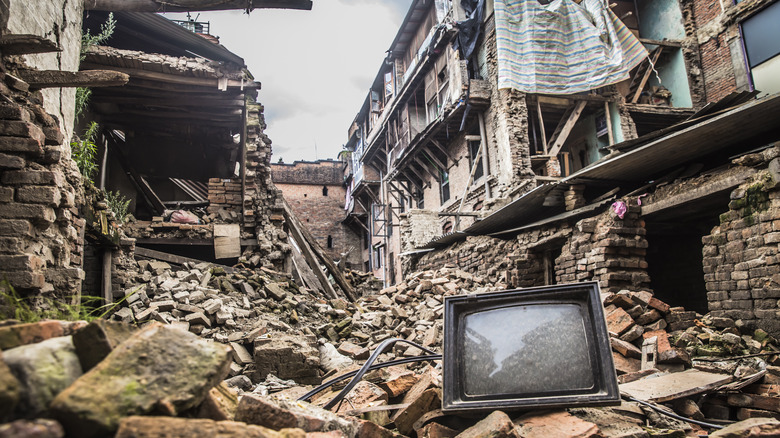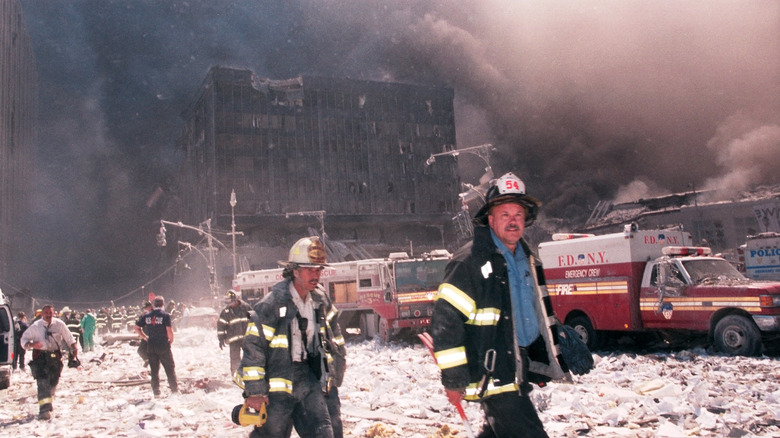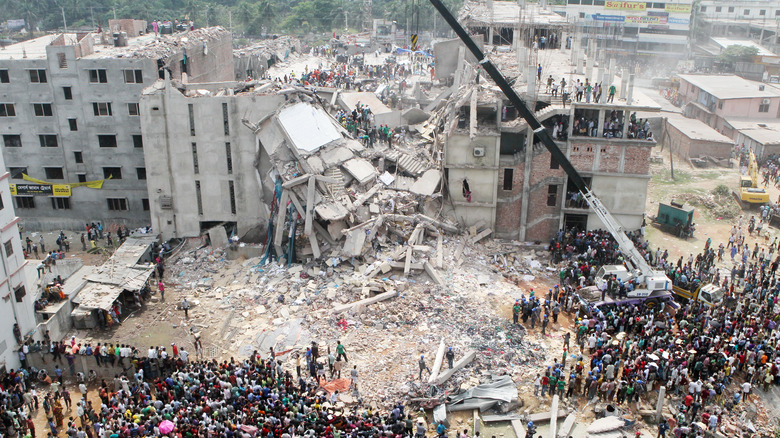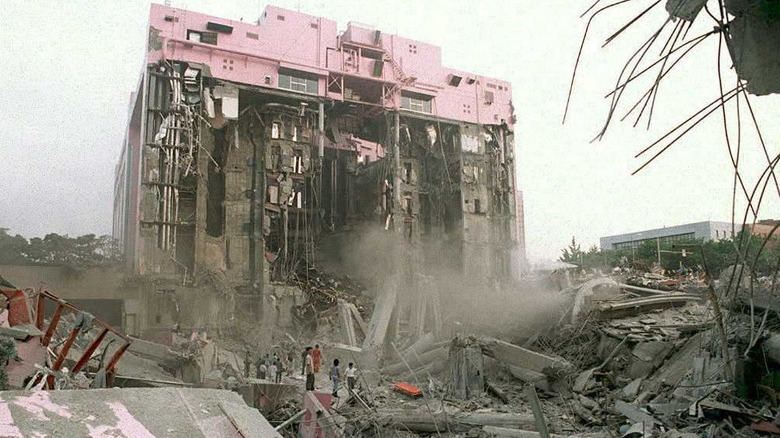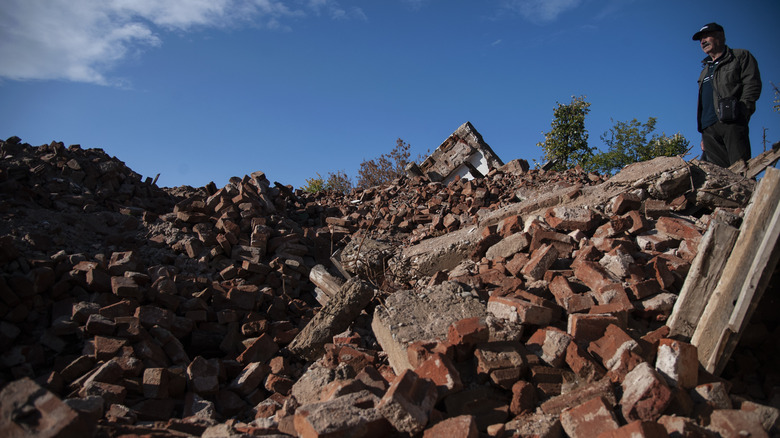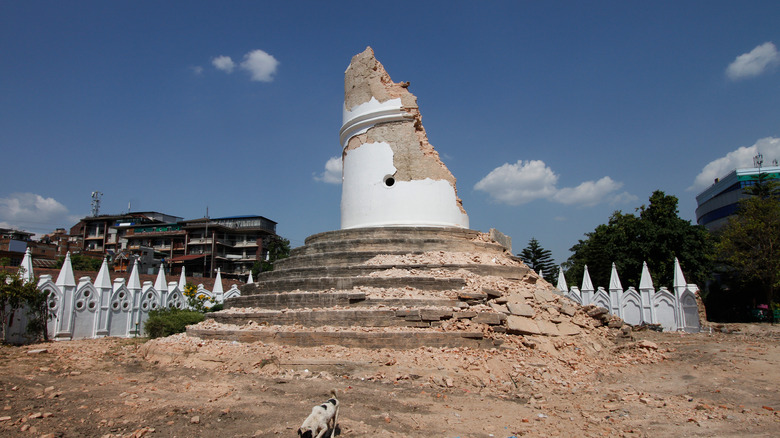The Deadliest Building Collapses In History
No one expects a home, hospital, place of business, work, etc. to collapse without notice. It's what makes these types of disasters so terrifying. Luckily, large and bustling buildings aren't usually the ones that fall to the ground. They're built to be sturdy — contractors want their multimillion-dollar work to last for several lifetimes after all — but when a smaller building collapses, the number of deaths tend to stay comparatively low. The unfortunate side of this is that larger buildings do sometimes come tumbling down, and when they do, they're monumental disasters that shake the world to its core. Not to mention, countless bereaved friends and family members of those caught beneath shattered concrete walls and twisted beams are left grieving the tragedy.
With the recent collapse of the Champlain Towers South condo building in Surfside, Florida, with what CNN measures as at least 11 casualties and 150 missing residents as of the writing of this article, it has the possibility beat out the Canterbury Television Building collapse — 115 casualties — of 2011 and the Weiguan Jinlong collapse — 114 casualties — of 2016 as one of the most deadly of these types of incidents known to history. Hopefully, the casualties stay low, though it seems the death toll is still on the rise. But even with such tragic numbers, the aforementioned travesties don't hold a candle to the deadliest building collapses in history.
The World Trade Center destroyed in terrorist plot
On the morning of September 11, 2001, both air passengers and pedestrians were expecting to have a normal day, but a terrorist plot had other plans for them. Most of you know this story already since the vast majority of us were around that morning while the world went still. Here are the highlights for those who might not have been: A series of planes were hijacked by the terrorist group known as al-Qaeda. The planes were then crashed into the World Trade Center (twin towers) in New York, the Pentagon, and the Pennsylvania countryside. Then, the twin towers collapsed.
According to Britannica, around 2,750 people were killed in the collapse of the World Trade Center, which includes citizens on the street outside the building as well. These were the tallest buildings in the world during their day, each, as noted by the 9/11 Memorial website, containing roughly 250,000 tons of steel, concrete, glass, and other building materials. When the towers went down, their crash radius was far-reaching.
As if the twin towers attack wasn't deadly enough on its own, around 400 emergency personnel assisting in the rescue also died, while many others were injured. The attack on the Pentagon and the plane that went down in Pennsylvania after passengers attempted to regain control of the vessel would add another 224 to the death toll, but even without those extra numbers, the twin tower disaster is the deadliest building collapse in history.
Rana Plaza collapsed due to negligence
If your house was damaged and ready to fall in on itself, you'd probably sleep on a friend's couch or find a nice motel room to hunker down in until it's repaired, right? And, that's basically what should've happened with the eight-story building in Bangladesh housing five separate garment factories, but money is a powerful motivator to some, and greed can breed negligence. The Human Rights Watch says workers had been complaining about creaking and groaning sounds emanating from cracks within the structure of the building the day before it collapsed, which would've made a good enough excuse for employees to call in sick for a couple of days. Of course, workers were forced to go back into these unsafe conditions anyway, since the garment industry is what keeps a lot of people fed in the area.
On April 24, 2013, Rana Plaza went down. The International Labour Organization estimates at least 1,132 people died in the rubble, with nearly 2,500 left injured. This is the second-deadliest building collapse in history, and it's one that could've been avoided if the building met building code legislation. Like so many others in the area, it did not. The deaths of these poor workers were, unfortunately, needed to open international eyes to the poor working conditions the people in this part of the world are forced into. An area with some of the lowest pay and highest rates of workplace accidents in the world.
The Sampoong Department Store collapse was a mess of poor decisions
South Korea's rise has been near meteoric since the Korean War in the 1950s. From war-torn country to an economic force, few nations have grown to make the type of name for themselves that South Korea has, but the rapid nature of that growth played a part in the Sampoong Department Store collapse in Seoul in 1995.
The department store wasn't the only building to be destroyed in the couple of decades leading to its collapse. According to The Guardian, apartment buildings had fallen, bridges had given out, a hotel went up in flames, and a train station blew up. The rise of South Korea wasn't looking so grand for a minute there, as important factors everywhere seemed to have been overlooked while the country pushed desperately to raise buildings to the sky metaphorically overnight.
The list of poor building decisions that culminated in Sampoong's destruction is extensive. Firstly, it was built over an old landfill. Next, the building switch from a residential structure to a commercial one that necessitated the removal of support beams and the circumventing of zoning codes. Then, a heating system was run under the building, stressing the too-few supports even further. And, finally, 45-ton air conditioning units were dragged across the roof, creating cracks in the structure that widened over time from the system's vibration until the whole thing crumbled two years later. In all, 502 people were killed in the incident.
Dzhrashen school was taken out by an earthquake
Finally, we come to a building that collapsed for a reason that actually makes sense... mostly. Earthquakes can range anywhere from slight vibrations to a force that rips chasms in the planet's crust or levels entire cities, and the latter is the type of natural disaster that caused the collapse of Dzhrashen elementary school near Spitak, Armenia, in the winter of 1988. As a report on earthquake damage to schools around the world from the U.S. Department of Commerce: National Oceanic and Atmospheric Administration explains, the tremors that destroyed Dzhrashen were anything but minor. The quake weighed in at a heavy 6.9 on the Richter scale and was responsible for $14.2 billion in damages. Over 500,000 people were left homeless, 15,000 were injured, and around 25,000 were killed.
The Dzhrashen school had the most concentrated death toll in the area, with 400 people dead on the one site alone. What makes this disaster even more devastating is how it occurred at an elementary school, meaning the majority of these deaths were likely young children. That'll pull at anyone's heartstrings.
The earthquake didn't do all the damage on its own. As the report mentions, the building collapsed when the concrete floor gave out due to being poorly affixed to the structure's walls. Had the structure been properly anchored, maybe things would've turned out differently.
Dharahara tower collapsed twice
The Dharahara tower is quite a tourist attraction, as are most things in Nepal. At present, a 22-story replica of the tower stands in Kathmandu, just waiting for photo ops. This replica tower, though, was just built and isn't even open to tourists until November 2021 since the original has been gone for most of a century. According to BBC, the original tower was built in the 1830s, courtesy of Nepal's first prime minister and stood until 1935 when an earthquake cause it to collapse for the first time. The tower was subsequently rebuilt, you know, so it could collapse again.
The second collapse, which took place in 2015, caused the deaths of at least 180 people, mostly tourists, according to NDTV. Again, an earthquake was at fault, and it was much larger than the first, recording at 7.9 on the Richter scale. That isn't too far from making the USGS's list of 20 Largest Earthquakes in the World, to give you some scope.
The new tower will have some additions, and likely some structural changes, to help it live through the next tremor that shakes Nepal. Elevators, garden, fountain, museum, you name it. If Dharahara tower is anything, it's a phoenix that's risen from its own ashes time and again.
